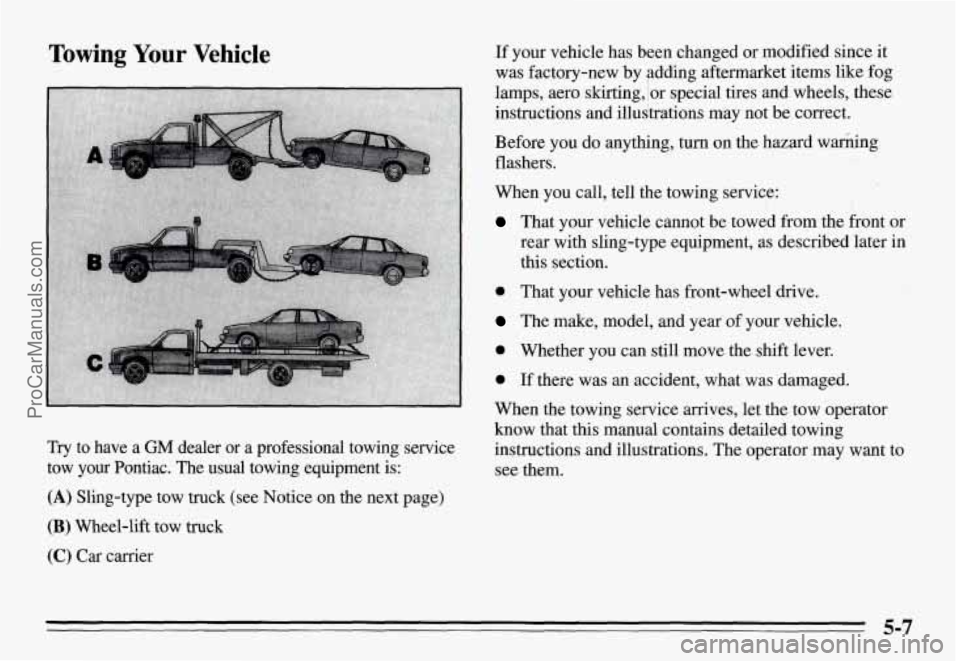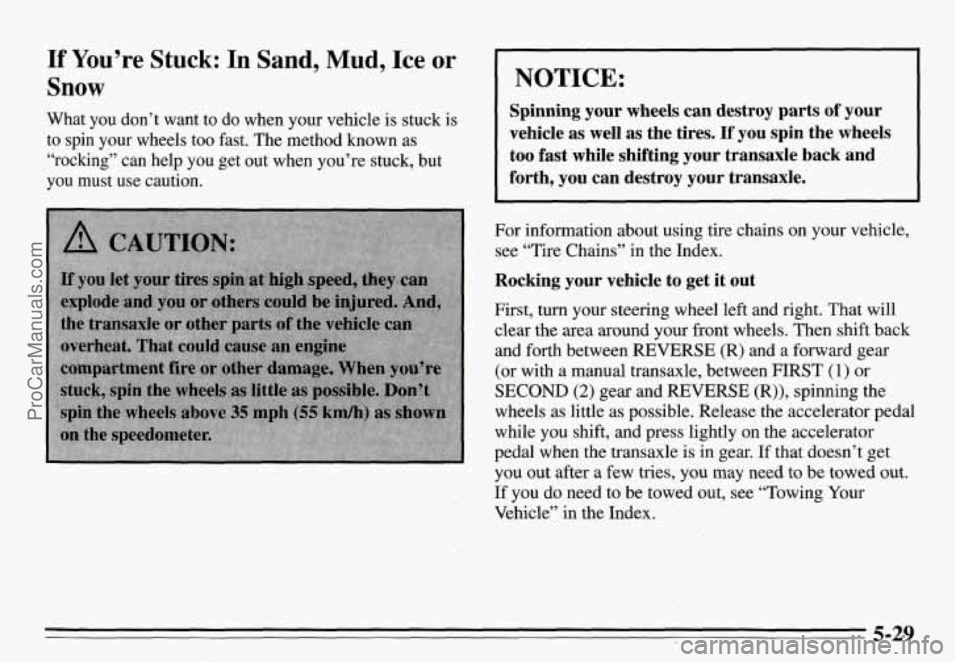Page 180 of 354
When You Are Ready to Leave After
Parking on a Hill
1. Apply your regular brakes and hold the pedal down
while you:
Start your engine;
Shift into a gear; and
Release the parking brake.
2. Let up on the brake pedal.
3. Drive slowly until the trailer is clear of the chocks.
4. Stop and have someone pick up and store the chocks.
Maintenance When Trailer Towing
Your vehicle will need service more often when you’re
pulling a trailer. See the Maintenance Schedule for more
on this. Things that are especially important in trailer
operation are automatic transaxle fluid (don’t overfill),
engine oil, belt, cooling system, and brake adjustment.
Each
of these is covered in this manual, and the Index
will help you find them quickly. If you’re trailering, it’s
a good idea to review these sections before you start
your trip.
Check periodically to see that all hitch nuts and bolts are
tight.
4-37
ProCarManuals.com
Page 188 of 354

Towing Your Vehicle
Try to have a GM dealer or a professional towing service
tow your Pontiac. The
usual towing equipment is:
(A) Sling-type tow truck (see Notice on the next page)
(B) Wheel-lift tow truck
(C) Car carrier
If your vehicle has been changed or modified since it
was factory-new
by adding aftermarket items like fog
lamps, aero skirting, (or special tires and wheels, these
instructions and illustrations may not be correct.
Before you
do anything, turn on the hazard warhing
flashers.
When you call, tell the towing service:
That your vehicle cannot be towed from the front or
rear with sling-type equipment,
as described later in
this section.
0 That your vehicle has front-wheel drive.
The make, model, and year of your vehicle.
0 Whether you can still move the shift lever.
0 If there was an accident, what was damaged.
When the towing service arrives, let the tow operator
know that this manual contains detailed towing
instructions and illustrations. The operator may want to
see them.
5-7
ProCarManuals.com
Page 189 of 354
When your vehicle is being towed, have the ignition key
off. The steering wheel should be clamped in a
straight-ahead position, with a clamping device
designed for towing service. Do not use the vehicle’s
steering column lock for this. The transaxle should be in
NEUTRAL (N) and the parking brake released.
The ignition key must be in the OFF position to prevent
the automatic door locks from locking during towing.
Don’t have your vehicle towed on the front wheels,
unless you must.
If the vehicle must be towed on the
front wheels, don’t go more than
35 mph (55 km/h) or
farther than
50 miles (80 km) or your transaxle will be
damaged.
If these limits must be exceeded, then the
front wheels have to be supported on
a dolly.
ProCarManuals.com
Page 190 of 354
Towing from the Front -- Vehicle Hookup
Before hooking up to a tow truck, be sure to read all the
information in “Towing Your Vehicle” earlier
in this
section.
5-9
ProCarManuals.com
Page 191 of 354
I NOTICE: I
Do not tow with sling-type equipment or
fascidfog lamp damage will occur. Use wheel-lift
or car carrier equipment. Additional ramping
may be required for car carrier equipment.
NOTICE:
Towing a vehicle over rougn sunaces could
damage a vehicle. Damage
can occur from vehicle
to ground or vehicle to wheel-lift equipment.
To
help avoid damage, install a towing dolly and raise
the vehicle until adequate clearance is obtained
between the ground and/or wheel-lift equipment.
Do not attach winch cables or J-hooks to
suspension components when using car carrier
equipment. Always use T-hooks inserted in the
T-hook slots.
Attach T-hook chains into the slots in the
bottom of the floor pan,
just behind the front wheels
on
both sides.
Attach a separate safety
chain around the outboard
end
of each lower control
5-10
ProCarManuals.com
Page 192 of 354
Towing from the Rear -- Vehicle Hookup
TOW LIMITS-35 MPH (55 KPH), 50 MILES
(80 KM)
Before hooking up to a tow truck, be sure to read all the
information in “Towing
Your Vehicle” earlier in this
section.
Also be sure to use the proper hook-up for your
particular vehicle.
NOTE: The ignition key must be in the OFF position to
avoid the automatic door lock from locking during tow.
Attach T-hook chains on
both sides, in the slotted
holes in the underbody,
just ahead
of the wheels.
NOTICE:
Do not tow with sling-type equipment or rear
bumper valance will be damaged. Use wheel-lift
or car carrier equipment (additional ramping
may be required for car carrier equipment). Use
safety chains and wheel straps.
5-11
ProCarManuals.com
Page 193 of 354
NOTICE:
Towing a vehicle over rough surfaces could
damage a vehicle. Damage can occur from vehicle
to ground or vehicle to wheel-lift equipment. To
help avoid damage, install a towing dolly and
raise the vehicle until adequate clearance is
obtained between the ground and/or wheel-lift
equipment.
Do not attach winch cables or J-hooks to
suspension components when using car carrier
equipment.
Always use T-hooks inserted in the
T-hook Slots.
Attach a separate safety
chain to each side of the
axle inboard
of the spring.
Engine Overheating
You will find a coolant temperature gage or the warning
light about
a hot engine on your Pontiac’s instrument
panel. See “Coolant Temperature Gage” and “Coolant
Temperature Warning Light” in the Index. You will also
find a low coolant warning light on your Pontiac’s
instrument panel.
5-12
ProCarManuals.com
Page 210 of 354

If You’re Stuck: In Sand, Mud, Ice or
Snow
What you don’t want to do when your vehicle is stuck is
to spin your wheels too fast. The method known as
“rocking” can help you get out when you’re stuck, but
you must use caution.
For information about using tire chains on your vehicle,
see “Tire Chains” in the Index.
I NOTICE: I
Spinning your wheels can destroy parts of your
vehicle
as well as the tires. If you spin the wheels
too fast while shifting your transaxle back and
forth, you can destroy your transaxle.
Rocking your vehicle to get it out
First, turn your steering wheel left and right. That will
clear the area around your front wheels. Then shift back
and forth between REVERSE
(R) and a forward gear
(or with a manual transaxle, between F’IRST
(1) or
SECOND
(2) gear and REVERSE (R)), spinning the
wheels as little as possible. Release the accelerator pedal
while
you shift, and press lightly on the accelerator
pedal when the transaxle is in gear.
If that doesn’t get
you out after a few tries, you
may need to be towed out.
If you do need to be towed out, see “Towing Your
Vehicle” in the Index.
5-29
ProCarManuals.com